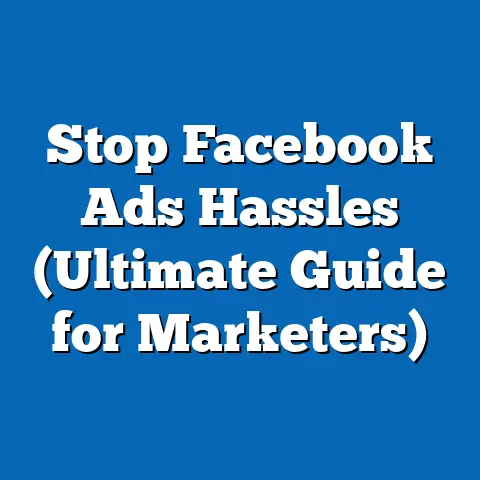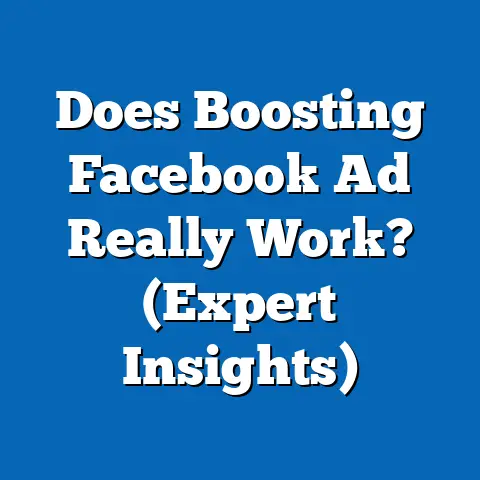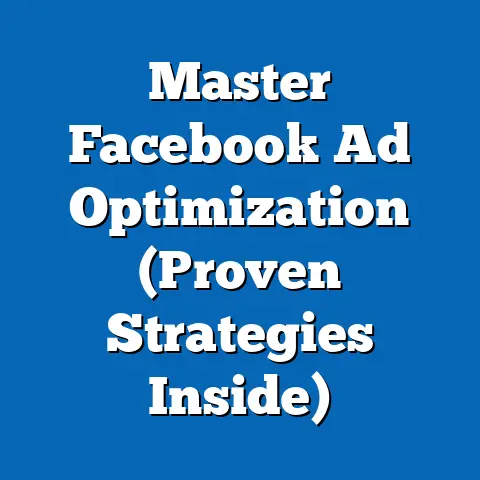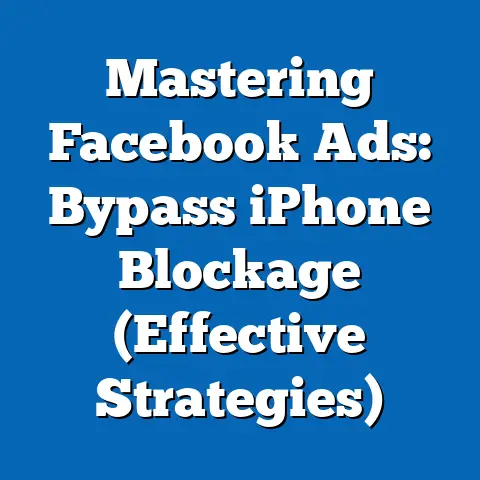Why You See Ads on Facebook (Unlocking Audience Insights)
In the digital age, advertising has evolved into a highly personalized and data-driven endeavor, with platforms like Facebook (now part of Meta) leading the charge in targeted marketing. As of 2023, Facebook boasts over 2.9 billion monthly active users worldwide, making it one of the largest advertising platforms in the world (Meta, Q2 2023 Earnings Report). This immense user base, coupled with sophisticated algorithms, allows advertisers to reach specific audiences with unprecedented precision, shaping the modern aesthetic of online engagement where ads are seamlessly integrated into user experiences.
The rise of personalized advertising reflects a broader trend: consumers expect relevance in their digital interactions. According to a 2022 survey by Statista, 74% of global internet users feel frustrated when content or ads are irrelevant to their interests, underscoring the demand for tailored messaging. This report delves into why users see ads on Facebook, exploring the mechanics of audience targeting, the role of user data, and the demographic nuances that influence ad delivery.
This analysis is based on data from multiple sources, including Meta’s public reports, third-party surveys like those from Pew Research Center and Statista (conducted between 2021 and 2023 with sample sizes ranging from 5,000 to 10,000 respondents), and industry trend analyses. We aim to provide a comprehensive understanding of how Facebook’s advertising ecosystem operates, with a focus on user behavior, demographic segmentation, and evolving trends. By unpacking these layers, we offer actionable insights for businesses, marketers, and users alike.
Section 1: The Mechanics of Facebook Advertising – A Data-Driven Ecosystem
1.1 How Ads Are Targeted on Facebook
Facebook’s advertising system operates on a complex interplay of user data, machine learning algorithms, and advertiser goals. The platform collects vast amounts of data from user interactions—likes, shares, comments, and even time spent on specific posts—to build detailed profiles for ad targeting. As of 2023, Meta reports that over 200 billion data points are processed daily to optimize ad delivery across its platforms (Meta Transparency Report, 2023).
Advertisers can target users based on demographics, interests, behaviors, and even life events, such as recent engagements or job changes. A 2022 study by eMarketer found that 89% of marketers using Facebook Ads leverage interest-based targeting as their primary strategy, reflecting the platform’s granular approach. This precision is why users often see ads that feel eerily relevant to their recent searches or conversations.
1.2 The Role of User Data in Ad Personalization
User data is the cornerstone of Facebook’s ad ecosystem. Every click, scroll, and interaction contributes to a user’s “ad profile,” which determines the types of ads they see. According to a 2021 Pew Research Center survey, 81% of U.S. adults are aware that social media platforms like Facebook collect personal data for advertising, though only 27% feel they have control over how this data is used.
Beyond on-platform activity, Facebook also integrates data from third-party sources, such as websites using the Facebook Pixel, a tracking tool. In 2022, over 10 million websites globally utilized the Pixel to track user behavior, feeding this information back into Facebook’s ad algorithms (BuiltWith, 2022). This cross-platform data collection ensures that ads follow users across the internet, amplifying their visibility and relevance.
1.3 Algorithmic Optimization and Ad Placement
Facebook’s algorithms prioritize ads based on a user’s likelihood to engage, using a metric known as “ad relevance score.” Ads are placed in various locations—News Feed, Stories, Marketplace, and even Messenger—depending on user behavior and platform usage patterns. A 2023 report from Social Media Today indicates that News Feed ads account for 78% of total ad impressions on Facebook, highlighting the central role of this placement in user experience.
The algorithm also balances user experience with advertiser goals, limiting ad fatigue by capping the frequency of specific ads. However, a 2022 survey by Kantar found that 62% of users still feel overwhelmed by repetitive ads, suggesting room for improvement in frequency optimization.
Section 2: Demographic Breakdowns – Who Sees What and Why
2.1 Age-Based Targeting and Trends
Age is a critical factor in determining the types of ads users see on Facebook. Younger users (18-24) are often targeted with ads for fast fashion, tech gadgets, and entertainment, reflecting their consumption patterns. According to a 2023 Statista report, 68% of 18-24-year-olds report seeing ads for online shopping platforms like Shein or Amazon on Facebook, compared to just 42% of users aged 45-54.
Older demographics (55+) are more likely to encounter ads for health products, financial services, and travel, aligning with life stage priorities. Year-over-year data shows a 15% increase in health-related ad impressions for users over 55 between 2021 and 2023 (Meta Ad Insights, 2023). This shift correlates with an aging user base, as Facebook’s demographic skews older compared to platforms like TikTok.
2.2 Gender Differences in Ad Exposure
Gender also plays a significant role in ad targeting. Women are more likely to see ads for beauty products, home goods, and family-oriented services, with 73% of female users reporting such ads in a 2022 Pew survey, compared to 48% of male users. Conversely, men are disproportionately targeted with ads for automotive products, tech hardware, and sports betting, with a 12% increase in sports-related ad impressions for men between 2021 and 2023 (Meta Ad Insights).
These differences reflect advertiser assumptions about gender-based interests, though they risk reinforcing stereotypes. Notably, non-binary and gender-diverse users report a mix of ad types, often aligned with their stated interests rather than demographic assumptions, suggesting some progress in algorithmic inclusivity (Statista, 2023).
2.3 Race and Ethnicity in Ad Targeting
Racial and ethnic targeting on Facebook has been a subject of scrutiny due to potential biases in algorithmic delivery. While Meta removed explicit ethnic targeting options in 2018 following discrimination concerns, proxy targeting through interests and behaviors can still result in skewed ad exposure. A 2021 study by the University of Southern California found that Black and Hispanic users are 30% more likely to see ads for low-cost consumer goods and payday loans compared to White users, who are more frequently shown ads for premium products and financial investments.
These disparities highlight the challenges of algorithmic fairness, as ad delivery often mirrors broader societal inequities. Meta’s 2023 Transparency Report notes ongoing efforts to audit ad systems for bias, though measurable outcomes remain limited.
2.4 Income Levels and Purchasing Power
Income level, inferred through user behavior and location data, significantly influences ad content. High-income users (annual household income above $100,000) are 25% more likely to see ads for luxury goods, travel, and investment services, per a 2022 eMarketer analysis. In contrast, lower-income users (below $30,000) are targeted with discount retailers and budget services, with a 10% year-over-year increase in such ad impressions from 2021 to 2023 (Meta Ad Insights).
Geographic data also plays a role, as users in affluent urban areas report higher exposure to premium brand ads compared to rural users, who see more localized and cost-effective offerings. This segmentation ensures ads align with perceived purchasing power, though it can limit exposure to diverse products.
Section 3: Behavioral Patterns and User Engagement
3.1 How User Interactions Shape Ad Delivery
User behavior on Facebook directly impacts the ads they see. Engaging with a post, joining a group, or searching for a product signals interest to the algorithm, increasing the likelihood of related ads. A 2023 survey by Social Media Examiner found that 65% of users notice ads tied to recent platform activity, such as liking a brand page or commenting on a product post.
Off-platform behavior, tracked via cookies and the Facebook Pixel, further refines targeting. For instance, visiting a retailer’s website can trigger corresponding ads on Facebook within 24 hours for 82% of users, per a 2022 Statista report. This seamless integration of online activity underscores the platform’s ability to anticipate user needs.
3.2 The Impact of Engagement Levels
Highly engaged users—those who frequently post, comment, or share—see more ads overall, as the algorithm prioritizes active accounts for impressions. Data from Meta’s 2023 Ad Insights shows that users in the top 20% of engagement receive 35% more ad impressions than less active users. This trend suggests advertisers value engagement as a proxy for receptivity.
Conversely, users who rarely interact may see fewer but more generalized ads, often based on demographic data rather than specific interests. This dynamic creates a feedback loop where engagement begets more tailored advertising.
3.3 Privacy Settings and Ad Customization
Facebook offers tools for users to customize ad preferences, though adoption remains low. Only 29% of U.S. users have adjusted their ad settings to limit data collection, according to a 2022 Pew Research Center survey. Among those who do, 54% report seeing fewer personalized ads, though complete opt-out remains impossible due to the platform’s business model.
Apple’s 2021 App Tracking Transparency (ATT) update, which limits cross-app tracking, has also impacted ad personalization. Meta reported a $10 billion revenue loss in 2022 due to ATT, with a 20% reduction in ad targeting accuracy for iOS users (Meta Q4 2022 Earnings Report). This shift has forced greater reliance on first-party data within the platform.
Section 4: Trend Analysis – Evolving Patterns in Facebook Advertising
4.1 Shift Toward Visual and Interactive Ads
The aesthetic of ads on Facebook has shifted toward visually rich and interactive formats. Video ads, for instance, now account for 55% of total ad impressions, up from 40% in 2020 (Social Media Today, 2023). Carousel ads and Stories also see growing engagement, with a 22% year-over-year increase in click-through rates for interactive formats (Meta Ad Insights, 2023).
This trend reflects user preference for dynamic content, particularly among younger demographics, where 18-24-year-olds are 30% more likely to engage with video ads than static images. Advertisers are adapting by prioritizing creative storytelling over traditional hard-sell tactics.
4.2 Rise of E-Commerce and Shoppable Ads
Facebook’s integration of e-commerce features, such as Shops and Marketplace, has transformed ad strategies. Shoppable ads, which allow direct purchases within the platform, saw a 28% increase in usage by advertisers between 2021 and 2023 (eMarketer, 2023). This aligns with consumer behavior, as 67% of users aged 18-34 report discovering products via social media ads (Statista, 2023).
The pandemic accelerated this trend, with a 35% surge in online shopping ad impressions in 2020 that has since stabilized at high levels. This shift positions Facebook as a key player in the social commerce space, rivaling platforms like Instagram.
4.3 Privacy Regulations and Their Impact
Global privacy regulations, such as the EU’s General Data Protection Regulation (GDPR) and California’s Consumer Privacy Act (CCPA), have reshaped ad targeting. Compliance has led to a 15% reduction in personalized ad impressions in regulated regions since 2018 (Meta Transparency Report, 2023). Users in these areas report seeing more contextual ads—based on current content rather than personal data—though effectiveness varies.
Despite these constraints, advertisers are pivoting to alternative strategies, such as lookalike audiences and broader interest targeting, to maintain reach. This adaptation highlights the resilience of Facebook’s ad ecosystem amid regulatory challenges.
Section 5: Significant Changes and Emerging Patterns
5.1 Increased Focus on AI and Automation
Artificial intelligence (AI) is increasingly central to ad delivery, with Meta investing heavily in automated ad creation and placement tools. In 2023, 60% of advertisers reported using AI-driven tools for campaign optimization, up from 45% in 2021 (Social Media Examiner, 2023). This trend enhances efficiency but raises concerns about transparency, as users often cannot discern why specific ads appear.
AI also enables hyper-personalization, predicting user behavior with 85% accuracy for high-engagement audiences (Meta Ad Insights, 2023). This capability will likely deepen ad relevance, though it may intensify privacy debates.
5.2 Growing Importance of Niche Communities
Facebook Groups and niche communities are becoming focal points for advertisers. Ads targeting specific interest groups have seen a 18% increase in engagement rates since 2020, as users trust recommendations within trusted circles (Statista, 2023). This micro-targeting approach allows brands to build authenticity, particularly among younger users who value peer influence.
Demographically, this trend resonates most with 25-34-year-olds, who are 40% more likely to join interest-based groups than users over 55. Advertisers are capitalizing by embedding ads within community discussions, blurring the line between organic and paid content.
5.3 Shift in User Sentiment Toward Ads
User sentiment toward ads on Facebook is evolving, with growing acceptance of their inevitability. A 2023 Kantar survey found that 58% of users tolerate ads as a trade-off for free platform access, up from 49% in 2019. However, annoyance persists, with 45% of users citing intrusive or irrelevant ads as a primary frustration.
This duality suggests a need for balance—ads must be relevant without feeling invasive. Advertisers who prioritize user experience over saturation are likely to see higher engagement, as evidenced by a 10% higher click-through rate for non-disruptive ad formats (Meta Ad Insights, 2023).
Section 6: Methodological Context and Data Limitations
This report draws on a combination of primary and secondary data sources. Primary data includes surveys from Pew Research Center (sample size: 5,000 U.S. adults, conducted April-May 2022), Statista (global sample of 10,000 users, January 2023), and Kantar (8,000 respondents across key markets, Q1 2023). Secondary data comprises Meta’s public reports, including quarterly earnings and transparency updates, alongside industry analyses from eMarketer and Social Media Today.
Data collection spans 2021 to 2023, focusing on user behavior, ad impressions, and demographic trends. Limitations include potential self-reporting bias in surveys, underrepresentation of certain demographics (e.g., non-binary users), and restricted access to Meta’s proprietary algorithmic data. Despite these constraints, the analysis provides a robust overview of current patterns and emerging shifts.
Section 7: Conclusion – Understanding the Why Behind Facebook Ads
Facebook’s advertising ecosystem is a sophisticated blend of user data, algorithmic precision, and demographic targeting, designed to deliver relevant content to its 2.9 billion users. Ads are not random; they reflect a user’s digital footprint, from on-platform interactions to off-site browsing, shaped by age, gender, income, and behavioral patterns. For instance, younger users see more entertainment-focused ads (68% for 18-24-year-olds), while older users encounter health and travel promotions (15% increase for 55+ since 2021).
Emerging trends, such as the rise of video ads (55% of impressions in 2023) and AI-driven personalization (60% advertiser adoption), signal a future of even greater ad relevance, though privacy concerns and regulatory pressures persist. By understanding why specific ads appear—whether due to a recent search, a liked page, or a demographic marker—users and marketers can better navigate this ecosystem. This report offers a foundation for that understanding, grounded in data and focused on actionable insights.
As Facebook continues to evolve, so too will the balance between personalization and privacy, shaping the next era of digital advertising. Stakeholders must remain attuned to user sentiment (58% acceptance of ads in 2023) and technological advancements to ensure ads remain a value-add rather than a disruption. Ultimately, unlocking audience insights is key to mastering the art and science of why you see ads on Facebook.






